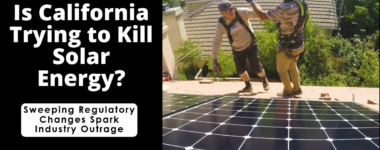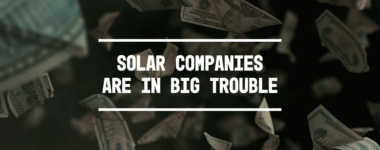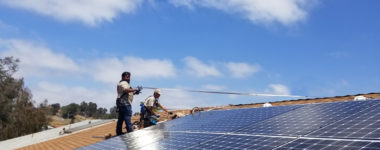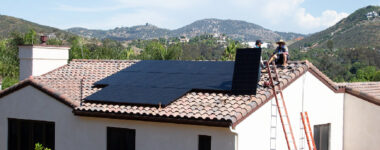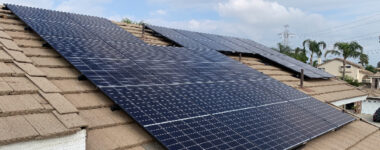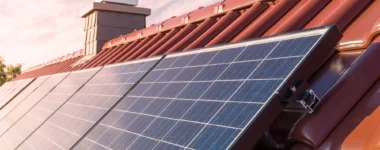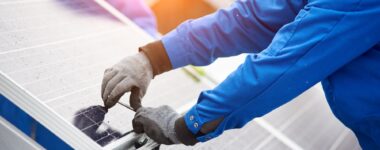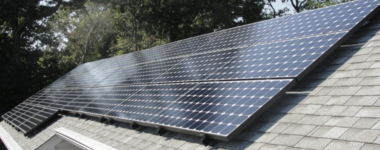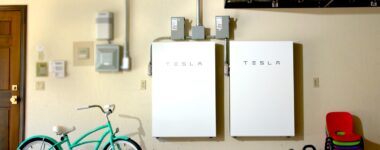Blog Post | Solar Panels, Battery Storage, Roofing, HVAC
Welcome to the electrifying world of utility companies, where profits are surging like a high-voltage current and customers are feeling the shock with every bill. In a year that saw Pacific Gas and Electric Company (PG&E) announce a nearly 25% increase in profits, reaching over $2.2 billion, residents across California are left pondering the balance between essential service costs and corporate earnings. This staggering figure serves as the spark for our exploration into why utility bills are climbing and how the giants of the energy sector are faring amidst growing public scrutiny. Strap in as we illuminate the complex dynamics of power, profit, and public opinion in today's energy landscape. Sempra Energy and SDG&E's Financial Performance Sempra Energy's Profits in 2023 Sempra Energy, the powerhouse behind San Diego Gas & Electric (SDG&E), recently announced it made close to a cool $3 billion in profits last year. Yes, billion with a "B." SDG&E's Contribution to Sempra's Profits Drilling down, SDG&E itself pulled in over $936 million in profit, up from the year before. Interesting to note, Sempra mixed up its reporting style this year, combining SDG&E's numbers with those of another subsidiary, making it a tad harder to see SDG&E's exact impact. Sneaky, right? Public Response and Advocacy Protests Against Sempra and SDG&E Not everyone is cheering for Sempra's victory lap. Power San Diego, a group advocating for energy fairness, took to the streets, demanding a shift to a non-profit utility model. Their point? If public utilities can charge less, why can't we get a piece of that pie? The Case for Municipal Utilities The argument is pretty straightforward: if the city runs its own utility, it wouldn't need to chase profits, potentially leading to lower bills for us folks. Imagine more money for fun and less for kilowatts. PG&E's Profit Increase and Customer Reaction PG&E's Profit Surge in 2023 Moving north to PG&E territory, the plot thickens. PG&E announced a nearly 25% jump in profits, crossing the $2.2 billion mark. This hike comes hot on the heels of rate increases that had customers steaming more than their morning lattes. Customer Dissatisfaction For many PG&E customers, the service doesn't seem to match the price tag. Outages remain a sore point, leading some to wonder where all that extra money is actually going. Calls for Regulatory Changes Advocacy for Rate Increase Caps With tensions boiling, groups like The Utility Reform Network (TURN) are calling for a cap on rate increases. Their idea? Tie hikes to something we all understand – the cost of living adjustment for social security. Utility Companies' Future Plans Despite the backlash, companies like PG&E are talking up their investment plans, promising to keep future increases within inflation rates. But for many, that promise is as comforting as a flickering lightbulb in a storm. As we flick off the switch on our exploration of the utility sector's rising profits against the backdrop of increasing customer bills, a few illuminating points stand out. The stark contrast between PG&E and Sempra Energy's ballooning profits, including a nearly 25% increase to over $2.2 billion for PG&E, and the palpable frustration of Californians grappling with higher rates, highlights a growing tension between energy providers and the communities they serve. While utility companies like Sempra defend their rate hikes as necessary for investment in safety, reliability, and green energy, customers and advocacy groups are calling for transparency, fairness, and regulatory reforms to ensure that utility services remain affordable without compromising on quality and environmental commitments. The debate over public versus investor-owned utilities, underscored by movements like Power San Diego, adds another layer to this complex conversation, suggesting a potential shift in how we think about and manage our energy resources. As we move forward, the energy narrative in California and beyond continues to evolve, balancing the scales between profit, people, and the planet remains a critical challenge that demands attention, action, and accountability from all stakeholders involved. Solar Power: The Key to Beating Rising Energy Bills In the face of soaring utility costs, solar power shines as a proven solution for California homeowners seeking relief. Semper Solaris, a local and veteran-owned leader in residential solar, stands ready to guide you towards energy independence. With a decade of expertise in solar installation, they offer hope for those overwhelmed by unpredictable energy expenses. Take a significant step towards slashing your energy bills by embracing the sun's potential. Contact Semper Solaris today for a free estimate on your solar transition. Unlock a future of savings and sustainability with the best in the business.
Welcome to the sunny state of California. Where the sun shines bright but the future of rooftop solar energy is facing some clouds. In a state that's been a trailblazer for renewable energy, recent decisions by the California Public Utilities Commission (CPUC) have sparked a heated debate in the solar industry. It's a story of policy shifts and unintended consequences. Despite California's impressive record of generating almost 20% of its electricity from solar in 2022, recent regulatory changes are casting a shadow over the state's solar progress. Let's unpack these changes and explore what they mean for the future of solar energy in California. CPUC's Decision to Cut Rooftop Solar Incentives So, the California Public Utilities Commission (CPUC) made a move that ruffled some feathers. Initially, they lowered the money households could get from their rooftop solar systems. But there was a twist. They were encouraging people to add batteries to these systems. The idea was that these batteries could store solar energy during the day. Then help out the grid by releasing it when the sun goes down and the demand for electricity goes up. Further Reductions and Industry Backlash Just when people were adjusting to these changes, the CPUC dropped another bombshell. They decided that solar-plus-battery systems wouldn't get full compensation for the grid assistance they provide. This decision hasn't gone down well with the solar industry. Industry leaders and trade groups are calling it a "bait-and-switch" tactic. This decision is definitely not helping the solar market in California. Economic Impacts on the Solar Industry Speaking of struggles, let's talk numbers. Since these policy changes, the rooftop solar industry has taken a hit. We're seeing a significant drop in solar installations, about 80% less than before. And it gets worse. Around 20,000 solar workers have lost their jobs. It's a tough time for those in the solar sector. Future Challenges and Utility Proposals The plot thickens with some upcoming proposals from major utilities in California. They're talking about adding fixed monthly charges for all ratepayers. These rates could be around $30 to $70 a month. This move might hit those with smaller electric bills harder. Adding another layer of complexity to the whole solar energy industry. The Bright Side: Solar Still a Smart Choice in California In the midst of the recent policy upheavals, it's crucial to spotlight a key fact. Solar energy remains a more affordable and sustainable energy solution for Californians. While the regulatory landscape might seem daunting. The fundamental benefits of solar energy haven't dimmed. By making the switch to solar, you're not just reducing your carbon footprint. You're also taking a stand against the unpredictability and often high costs associated with traditional energy companies. It's a step towards energy independence. A way to free yourself from the fluctuations and greed often associated with the energy market. In this context, choosing the right partner for your transition to solar is more important than ever. This is where Semper Solaris, a veteran-owned and local company, shines brightly. With over a decade of experience in the solar industry, Semper Solaris embodies reliability and expertise. Their deep roots in the community and commitment to service reflect the core values of trustworthiness and excellence. Choosing Semper Solaris isn't just about installing solar panels. It's about joining hands with a partner who understands the local landscape, the specific challenges Californians face, and the best ways to navigate these new policy changes. Their veteran-owned status adds a layer of dedication and discipline to their work ethic. Ensuring that your transition to solar is smooth, efficient, and tailored to your specific needs. Despite the recent policy changes, solar energy continues to be a beacon of hope and a wise choice for Californians looking to assert their energy independence. With a trusted partner like Semper Solaris, you can confidently embark on this journey, knowing you have experts by your side every step of the way. Declare your energy independence, embrace a sustainable future, and let Semper Solaris guide you towards a brighter, more affordable tomorrow.
If you're a homeowner in California, the reality of rising energy costs has already hit your wallet. Prices have increased 45.9% over recent years. That increase is a rate 271% higher than the general inflation rate of 16.9%. This is a massive increase, creating financial stress in households statewide. Rising Energy Costs in California Recent data from Energy Toolbase paints a stark picture. On average California's rates have increased 15.3% from 2020 through 2023. This increase is placing a strain on homeowners. Imagine opening your monthly energy bill to find it much higher than the last month. Making matters worse, there seems to be no end in sight. This increase has an impact on Californian's daily lives. Every dollar spent on inflated energy bills is a dollar taken away from families' needs and aspirations. The Californian Struggle As living costs soar, Californians face a financial struggle. The rise in energy prices causes stress and uncertainty. When every dollar matters, being at the mercy of energy companies rising prices feels unjust. And it's not just about the financial strain. Scheduled blackouts and power losses, add to the woes of Californians. The Power of Solar: Energy Independence In this landscape of financial and energy uncertainty, solar power is a beacon of independence and stability. By harnessing the power of the sun, homeowners can break free from unpredictable energy costs. Solar panels, especially when combined with battery storage, offer a big advantage. Cost savings and uninterrupted power supply. No more unexpected blackouts, no more sudden price hikes. Solar power puts the control back in your hands, ensuring a stable, predictable energy bill month after month. Semper Solaris: California's Trusted Solar Power Experts Enter Semper Solaris. California's veteran-owned solar power experts. They have over a decade of experience in installing solar systems. Semper Solaris stands as a testament to reliability and trust. They are not just another company. They are a part of the community. Committed to empowering Californians in their fight against rising energy costs. Choosing Semper Solaris means choosing a partner that understands your struggles and offers tailored solutions for your energy needs. Embracing a Brighter Future The path to a brighter, more affordable future for Californians is powered by the sun. Solar power is not just an alternative. It's a necessity in our fight against energy companies and spiraling costs. With Semper Solaris, transitioning to solar is more than just an investment. It's a step towards energy independence, peace of mind, and a sustainable future. Don't let rising energy costs dim your life. Take control. Call 888-210-3366 today and get a free estimate on creating your solar-powered future.
In the wake of Pacific Gas and Electric's (PG&E) announcement of a nearly 13% rate increase starting January 1, 2024, homeowners from Santa Barbara to Humboldt counties are facing a significant financial burden. According to Mark Toney of TURN (The Utility Reform Network) “Last year alone, from the beginning of 2023 to the beginning of 2024, PG&E customers had a 30% increase. That’s in a single 12-month period. That is not sustainable.” This rate hike, which translates to an additional $40 to $60 monthly or $480 to $720 annually. It's a strain on the budgets of countless Californians. This increase is not an isolated event but marks the beginning of a series of anticipated hikes. In a move to cover expenses for storm repairs and wildfire mitigation, PG&E has filed for a further increase of $24 per month, set to take effect in March. However, the financial burden on consumers doesn't stop there. According to reports shared with shareholders, PG&E plans to recoup billions in spent funds, suggesting even steeper rate increases in the future. Why Are These Increases Happening? PG&E justifies this increase as necessary for covering costs related to wildfire mitigation and catastrophic events. However, there's growing concern over PG&E's financial priorities. Especially considering CEO Patricia K. Poppe's $50 million compensation. Her salary is the highest for any utility CEO in the United States. This juxtaposition of soaring executive pay with mounting customer bills has sparked a debate about corporate accountability. Additionally, it calls into question the role of regulatory bodies like the California Public Utilities Commission (CPUC) in safeguarding consumer interests. Public Outcry and Regulatory Scrutiny The CPUC's recent decision to green light this rate hike faced considerable public opposition. Thousands of comments poured in, voicing concerns over these increases. This backlash is not just about higher bills. It's a cry for fairness and transparency in a system where the balance between corporate profits and consumer affordability appears increasingly skewed. Relief Measures for the Affected For those struggling under the weight of these increases there are programs that can help. The California Alternate Rates for Energy (CARE) and the Family Electric Rate Assistance Program (FERA) provide a 30 to 35% discount on electric bills for low-income households. These measures are a drop in the ocean of need, evidenced by over 100,000 families having their power disconnected by PG&E in 2023. The Solar Alternative It’s no wonder the allure of solar power is growing stronger. People are tired of the relentless upward march of energy costs, and many are now seriously considering the switch to solar. The benefits are clear. Reduced dependence on utility companies, lower long-term costs, and a greener footprint. The 2024 rate hike by PG&E underscores a growing dilemma for California homeowners. Continue under the burden of rising energy costs? Or switch to solar power? As families across the state adjust their budgets to accommodate these higher bills, the conversation around energy becomes more critical. It's a conversation about economics, but also about the kind of future Californians want to build. Semper Solaris: Your Trusted Partner in the Solar Journey Choosing the right partner for your solar switch is crucial. Semper Solaris stands out as a beacon of reliability and expertise in the solar industry. With over a decade of experience, this local, veteran-owned company has built a reputation for excellence and trustworthiness. Why Choose Semper Solaris? Local Expertise, Veteran Values: Semper Solaris is not just a solar power company. They embody a commitment to service and quality. They bring a unique blend of military precision, integrity, and dedication to every project. This ethos translates into a deep understanding of local energy needs and challenges, ensuring that solutions are not only efficient but also perfectly tailored to each homeowner’s specific situation. Commitment to Quality and Customer Service: What sets Semper Solaris apart is its unwavering commitment to customer satisfaction. They prioritize clear communication, transparency, and high-quality service. From initial consultation to final installation, their team of experts ensures a seamless and hassle-free experience. Trust and Reliability: Over the years, Semper Solaris has earned the trust of countless homeowners through its consistent delivery of top-notch solar solutions. By choosing Semper Solaris, you're partnering with a company that values your trust and works tirelessly to maintain it. Make the Switch with Confidence Don't let rising energy costs dictate your future. Take the first step towards energy independence and sustainability today. Contact Semper Solaris for a free estimate. Call Semper Solaris at (888) 210-3366 and begin your journey to affordable, energy independence.
In 2023 SDG&E requested a revenue increase of 3.6 billion dollars over the next four years, a move that has angered the community and led to a grassroots movement that aims to shake up the energy landscape. "Power San Diego," a community-led initiative, is challenging the status quo, proposing a bold plan to replace San Diego Gas & Electric (SDG&E) with a not-for-profit public power utility. This ambitious move, spearheaded by determined San Diegans, is not just about altering power management—it's about reshaping the city's energy future. The Spark of Discontent San Diego, like many cities, has been grappling with soaring electricity rates, leaving residents searching for alternatives. The rising costs have stirred significant concern among residents already burdened by high costs of living. In response, Power San Diego emerged from this collective frustration, fueled by the desire for fairer prices and a sustainable energy approach. This initiative isn't just a protest against high rates; it's a vision for a different kind of energy future. The Vision of Public Power At the heart of Power San Diego's mission is the transition to a public power utility. This shift promises several advantages: Reduced Energy Rates: By moving away from the profit-driven model of SDG&E, a public utility aims to offer more affordable energy to residents. Protection of Rooftop Solar Installations: In an era where sustainable practices are crucial, safeguarding solar installations is key to encouraging renewable energy adoption. Local Energy Generation and Storage: Focusing on local solutions means more efficient, responsive, and tailored energy services for San Diegans. Bill Powers, the campaign's chair, encapsulates the sentiment driving this initiative: “The only way for us to be able to craft our own destiny as a city in both controlling our electric rates and coming up with the most cost-effective, smartest, innovative decarbonization clean energy plan is to have local control of the electric power utility. Without that local control, we do not control our destiny.” The Road to a Ballot Measure The journey for "Power San Diego" is undoubtedly an uphill one, fraught with bureaucratic and logistical hurdles. Yet, the resolve of its members and the support of the community signal a new era of energy management in San Diego, one where the power belongs to the people. The path to change is paved with challenges, and "Power San Diego" is gearing up for a significant one. The group is embarking on a mission to collect over 80,000 signatures to get their measure on the 2024 ballot. If successful, this would be the first step in what could mark a turning point in how San Diego manages energy. The Potential Impact The implications of this initiative are far-reaching. A public power entity could lead to: Lower Household Expenditures: Reduced energy rates mean more money in the pockets of San Diegans, a vital factor in a city where the cost of living is continuously on the rise. Environmental Progress: Emphasizing renewable energy sources aligns with global efforts to combat climate change, positioning San Diego as a leader in environmental stewardship. Community Empowerment: This initiative is a testament to the power of community action, showcasing how united voices can drive substantial change. Championing a Brighter, Independent Energy Future In the midst of this transformative energy movement, Semper Solaris, a renowned solar energy company, stands in support of "Power San Diego's" mission. Recognizing the immense potential of a more energy-efficient and independent San Diego, Semper Solaris is committed to being an integral part of this sustainable future. Their expertise in solar technology positions them as a key player in the transition towards renewable energy sources, aligning perfectly with the goals of creating a more environmentally friendly and economically viable energy landscape for San Diego. To explore the possibilities and benefits of solar energy for your home, contact Semper Solaris today for a free estimate. Embrace the change, be part of the movement, and help make San Diego an example of what a community can achieve when it takes control of its energy destiny.
The world of solar energy is facing some challenges, and it's not just about company stocks. If you're someone interested in or already using solar power, these issues could impact you directly. This article breaks down the recent financial hiccups in the solar industry – from credit problems to uncertain money situations – and explains how they might affect your access to, the cost of, and the reliability of solar solutions. Let's simplify the complexities of the solar world and find out what this could mean for you, the consumer, in this evolving era of energy choices. Related: Ready to go Solar with America's #1 Solar + Battery Installer? Click here to schedule an appointment Solar Power Company Stock Plunge: Unpacking the Financial Challenges A solar company's stock plunge is a consequence of a credit agreement default, liquidity concerns, ownership dynamics, potential liabilities, industry headwinds, and broader challenges in the clean-energy stock landscape. The company is actively working on solutions, but has expressed doubts about its ability to keep its operations running. 1. Credit Agreement Default A rooftop solar company majority-owned by TotalEnergies SE, faced a significant setback with a 41% drop in its stock. The root cause lies in a subsidiary's default under its credit agreement, attributed to delays in delivering third-quarter financial statements. 2. Liquidity Concerns The company raised alarms about potential liquidity issues. If lenders demand immediate repayment, meaning this solar company might struggle to meet its obligations and pay liabilities, leading to doubts about its ability to continue as a "going concern." 3. Ownership and Financial Support Despite these challenges, this solar company, backed by its majority owner TotalEnergies SE, is actively engaging in discussions with lenders and equity sponsors. Additionally, the company secured $50 million from its revolving credit facility, aiming to strengthen its long-term financial position. 4. Potential Liabilities and Cash Flow Challenges Analysts estimate potential liabilities exceeding $65 million for this solar company. Cash flow challenges pose concerns for dealers associated with the solar company, potentially leading to constraints. 5. Industry Headwinds This struggle is not isolated; it reflects broader challenges in the solar industry. The sector, particularly home solar companies, has been hit by a sales slowdown. Rising interest rates have made borrowing for solar installations more expensive, contributing to the industry's woes. 6. Clean-Energy Stocks in Turmoil Solar companies stock decline is part of a larger trend affecting clean-energy stocks. Central bank tightening has exacerbated challenges in the sector, with some solar power companies shares plummeting over 75% this year. It seems like the solar energy landscape is undergoing some significant shifts. With many experiencing a stock collapse, individuals and businesses are seeking alternative solutions, and Semper Solaris is emerging as a trusted choice for solar needs. Related: Go Solar with America's top Solar + Battery company? Click here to schedule an appointment Latest news: ADT Solar is no more? After shutting down a significant number of its branches three months ago, ADT has officially declared its exit from the residential solar sector. This strategic move, according to ADT Chairman, President, and CEO Jim DeVries, follows meticulous consideration and is anticipated to yield substantial operational and financial benefits for ADT. In expressing gratitude, DeVries acknowledged the support of employees, partners, and customers during this transitional period. How the Collapse of a Solar Company Can Affect You Installation and Maintenance Disruptions: Project delays for those planning to install solar panels. Uncertainty around ongoing maintenance services. Warranty and Support Uncertainty: Potential challenges in honoring warranties for existing solar systems. Limited post-installation support from the collapsed company. Market Confidence and Options: Shaken consumer confidence in the solar market. Potential reduction in options as smaller companies struggle to compete. Financial Impacts: Financial losses for shareholders or those with financial ties to the collapsed company. Potential impacts on investment portfolios or financial agreements. Industry-wide Changes: Triggering changes in the solar industry landscape. Possible effects on regulations, government incentives, and overall competitiveness of solar solutions. Environmental Considerations: Implications for environmental initiatives if the collapsed company had a focus on sustainability. Reassessment of eco-friendly choices for consumers prioritizing environmental considerations. Users online have been actively commenting about solar: "What happens to the warranties on the equipment and service agreements?" - Larry Yahoo Finance User "My system will pay off in 6 years, while charging my car and saving over $5.00 per gallon equivalent (California). At the same time I am in charge of my power and not some big corp." - droneguy Yahoo Finance User "My neighbor had an 18 panel, 8 kw, grid connected system installed about 3 years ago. He said that his electric bill before the panels was about $300/mo. After the panels were installed it dropped to about $40. He is paying a $139 monthly for the system but even while he is making payments it saves him about $120/month. I asked him the other day if he had it to do over would he get solar again and he said "Absolutely". Today's higher interest rates would raise that payment and reduce the monthly savings. It might mean the difference between a new solar customer or not." - RJ Yahoo Finance User Semper Solaris: A Beacon of Stability in the Solar Market In the wake of solar stock challenges and the current solar industry state, Semper Solaris stands out as a reliable and resilient player in the solar energy sector. As uncertainties surround one of the industry giants, individuals are turning to Semper Solaris for their solar solutions, finding assurance in the company's stability and commitment to providing top-notch solar services. Paving the Way for a Solar-Powered EV Future Semper Solaris not only provides solar solutions but also understands the evolving landscape of energy needs. For EV owners, the company offers tailored solar installations designed to seamlessly integrate with EV charging stations. This forward-thinking approach aligns with the growing demand for sustainable and efficient energy practices. Advantages of Solar for Electric Vehicle Owners: Cost Savings Environmental Impact Energy Independence Long-Term Investment There are many benefits to powering your EV with soar energy and as the automotive industry accelerates toward electrification, the need for innovative and sustainable energy solutions becomes paramount. Solar adaptation for EV owners not only addresses immediate charging challenges but also contributes to a cleaner and more resilient energy ecosystem. In the era of electric mobility, Semper Solaris stands as a beacon, guiding individuals toward a future where solar and EVs coexist harmoniously. Why consumers are turning to Semper Solaris as their go-to Solar Company: Proven Track Record: Semper Solaris has established itself as a leader in the solar industry, backed by a track record of successful installations and satisfied customers. Their commitment to quality and reliability has earned them a strong reputation. Comprehensive Solar Services: From solar panel installation to roofing, battery storage, and HVAC solutions, Semper Solaris offers a comprehensive suite of services. This versatility allows customers to address multiple energy needs under one trusted provider. Customer-Centric Approach: Semper Solaris prioritizes the customer experience. In a time when market uncertainties can create anxiety, their customer-centric approach ensures transparent communication, personalized solutions, and a smooth transition to solar energy. To Avoid Massive Energy Rate Increases: With electric companies such as PG&E (Recently passed a 13% rate hike for PG&E in the Bay Area) and SDGE (requested rate hike for 2024) continuously raising energy costs. Homeowners are rushing to find solutions such as partnering with Semper Solaris to install high producing Solar Panels and Battery Storages. The Shift Towards Solar Independence As individuals and businesses reevaluate their energy choices in the wake of the solar industry challenges, the trend towards solar independence becomes more pronounced. Semper Solaris, with its strong presence and dependable services, is becoming a beacon for those seeking a stable and customer-focused partner in their solar journey. It remains essential for consumers to conduct thorough research and choose a solar provider aligned with their specific needs and values. Semper Solaris, with its commitment to excellence, sustainability, and customer satisfaction, is poised to play a pivotal role in the evolving solar energy landscape. Ready to go solar? Click here to schedule an appointment Frequently Asked Questions: What happens to warranties on equipment and service agreements? A: The fate of warranties and service agreements depends on the specific circumstances of the collapsed solar company. Consumers should reach out to the company or seek legal advice for clarity on their individual situations. How will the collapse affect ongoing projects and maintenance services? A: Ongoing projects may face delays, and maintenance services might become uncertain. Consumers are advised to stay informed about the status of their projects and seek alternative solutions if necessary. A company that installed my solar panels is closed, how do I keep my solar panels running? A: If you had a company install your solar and they're no longer around, Semper Solaris can help you keep your panels running. All you have to do is click here to schedule a free consultation. What financial impacts could consumers face? A: Financial losses may occur for shareholders or those financially tied to the collapsed company. This could impact investment portfolios or existing financial agreements. Seeking financial advice is recommended. Are there changes in regulations and government incentives for solar solutions? A: The collapse could trigger industry-wide changes, potentially affecting regulations, government incentives, and overall competitiveness of solar solutions. Consumers should stay updated on any shifts in the solar landscape. How does the collapse impact consumer options in the solar market? A: Consumer confidence in the solar market might be shaken, leading to a potential reduction in options as smaller companies struggle to compete. Exploring alternative providers and staying informed is advisable. Should consumers reassess their eco-friendly choices post-collapse? A: Yes, environmental considerations may be affected if the collapsed company had a focus on sustainability. Consumers prioritizing eco-friendly choices should reassess their options in light of the collapse. Why are consumers turning to Semper Solaris? A: Consumers are turning to Semper Solaris due to its proven track record, offering comprehensive solar services, and prioritizing a customer-centric approach. The company's stability and commitment to excellence make it a reliable choice. How does Semper Solaris differentiate itself in the solar market? A: Semper Solaris stands out with by staying true to it self and to their customers, offering a range of services such as roofing, battery storage, and HVAC, and prioritizing a customer-focus approach. This stability makes it a reliable solar company for many years to come. What role does Semper Solaris play in the shift towards solar independence? A: In the wake of industry challenges, Semper Solaris becomes a beacon for those seeking stability and customer-focused solar solutions. The company plays a pivotal role in the evolving solar energy landscape. How should consumers choose a solar provider aligned with their needs? A: Thorough research is crucial. Consumers should evaluate providers based on their commitment to excellence, sustainability, and customer satisfaction. Semper Solaris, with its strong values, is poised to be a leading choice. Set up an appointment today and learn how Semper Solaris can help you! Click here to schedule an appointment. Sources: https://www.energy.gov/eere/solar/articles/benefits-powering-your-ev-solar-energy https://finance.yahoo.com/ https://finance.yahoo.com/news/adt-provides-solar-business-advances-220000420.html https://www.solarpowerworldonline.com/2024/01/adt-solar-to-close-remaining-branches-exit-residential-solar-business/#:~:text=ADT%20said%20that%20through%20the,may%20be%20up%20for%20sale
According to a recent news report, the number of solar panels in California has tripled since 2005. And with solar energy continuing to grow, it will only become more popular. California has created several solar power benefits to encourage more people to switch to green energy. San Diego solar incentives include tax benefits, net metering, and loans. Taking advantage of these benefits from the best solar companies in San Diego will help you live a more carbon-free life. Here's why solar is a worthwhile investment in San Diego. Tax Benefits San Diego solar incentives encourage green building and solar energy. The federal government and California offer generous tax rebates once you install solar panels on your property. Twenty-eight percent of Californians get their energy from a solar power company. You can get a 30 percent solar tax credit for solar installation. Furthermore, California offers even more benefits. Residents get a tax break from the best solar companies in San Diego, and businesses can receive even more. It's best to check with your tax preparer about taking full advantage of solar installation before you switch the solar power. Moreover, solar energy is excluded from property tax assessments in California. You'll lower your tax burden just by switching to solar. Net Metering The roofing and solar San Diego installation at your home will produce more solar energy than you need. Net metering allows you to sell back unused solar energy to the solar power company. In turn, you become eligible for net metering! This process allows you to make money from your home's roofing and solar San Diego panels. Here's the catch - you must be connected to the power grid. The money you will earn from net metering will vary monthly. However, you can use that money to pay for your solar installation. You can also use it for a vacation, college tuition, or even more green home improvements. Loans California offers several low-interest loan programs to help you pay for solar energy projects. You can seek out a financial institution with fixed rates. In addition to loans specific to solar energy, you could also take a home equity line of credit. San Diego residents can also take advantage of several solar programs aimed at low-income Californians if you don't feel you can't afford solar installation based on your financial situation. San Diego Solar Incentives San Diego solar incentives include tax benefits, net metering, and loans. Once you discover how these incentives work, it makes the decision to convert to solar energy much easier. Soon, you'll be enjoying the benefit of reducing your carbon footprint! Allow us to show you the benefits of solar energy in San Diego. Our team of skilled experts will answer any of your questions and calm any fears you might have about the system. Schedule your free quote today! We will show you how simple and easy installation at your home will reap many financial and environmental benefits!
If you live in San Diego and want to get the best from your home, it all comes down to the way you take care of your infrastructure. Roofing work is one of the most substantial upgrades that you can look into and is also among the most beneficial. A new roof will cost you about $9,000, according to national averages. Many of today's companies that provide roofing services also work on solar panel services. You can improve your home's energy efficiency by leaps and bounds, while also protecting the structure. This article will teach you all about working with roofing companies in San Diego that can also take care of your solar needs. Why It's Important to Hire Professional Roofing Roofing professionals are skilled and savvy, which is why you should rely on them when you need any kind of service. By leaning on the expertise of roofing companies in San Diego, you'll have a go-to professional that can help you with your roofing inspections, insulation work, replacements, and so much more. San Diego roofing and solar go hand in hand today. The professionals that you hire are often accustomed to handling both jobs. Relying on them can build more equity in your home and make it more functional as a whole. Consider Switching to Solar Make sure to speak with the top solar companies San Diego has to offer when you're ready to get some work done. There are several reasons that investing in solar panels could be a good idea for your household. A roofing company can assist you when you're interested in exploring this technology. The panels that they install will go on top of your existing roof, or they can build new roofing that comes complete with solar panels. Upgrading to solar will help you make eco-friendly improvements in your household. The United States Department of Energy says that there are several solar energy benefits, including: Switching to a cleaner and more sustainable form of electricity Reducing the amount of carbon emissions that you create Solar panels are aesthetically pleasing and will improve your roof It helps you reduce reliance on municipal utilities The monetary savings will keep adding up over the years Consider these benefits as you reach out to a solar panel company that offers these services. These pros will then help you match up with the right equipment for your project. Hire the Best Roofing Contractor If you need roofing work, make sure that you also look into the help of pros that are the best at what they do. Consider hiring pros that are part of professional roofer's associations and check with the Better Business Bureau (BBB). The pros that offer roofing services should also be vetted to make sure they're licensed and insured. Schedule a consultation that includes a price quote. They can let you know whether they also provide solar panel services, and you'll get the chance to view their portfolio of previous work. High-Quality Roofing and Solar Service By hiring the best roofing companies San Diego has to offer, it's easier for you to get the results that you need. This type of work is sophisticated and requires the help of proven pros. Whether you'd like to hire a roofer, a solar panel company, or both, there are plenty of businesses available today that can accommodate you. Semper Solaris can assist you when you're looking into high-quality roofing or need help installing solar panels. Schedule your appointment today!
Did you know that a solar panel can produce 2kWh of energy per day? That's a lot of potential savings on your energy bill. If you're looking for the best solar in San Diego, you've come to the right place. From the benefits of a solar system to how a solar battery in San Diego works, we've rounded up everything you need to know about how to choose a solar company. Let's dive in and see what to look for in a company when you're going solar. Learn How Their Solar Panels Work One of the first things you'll want to research is how the company's solar panels work. It's important to note that while the premise of solar panels may all be the same, they don't all work alike. You may find how one company that makes or uses its solar panels is a better fit for you. Semper Solaris, for example, uses reliable solar panels that will last for decades. They are also leaders in solar technology, making sure you have the most innovative products on the market today. With so much to choose from, you'll want an expert you can trust to guide you along the way. Solar panels convert sunlight into energy by absorbing it. Sunlight is turned into direct current (DC) which is then converted into alternating current (AC) energy. This is then used to power your home. We'll help you choose between the different types of solar panels to help you find the best for your home. The Benefits of Semper Solaris and San Diego Solar Power In San Diego, the sun is in full swing almost every day of the year. This is great for getting the most out of your solar panels. Unlike in other parts of the country where you see gray skies for days on end, San Diego provides year-round sun. With so much sun on a daily basis, it's amazing how much energy solar panels convert. While solar panels save money and energy all over the world, in places like San Diego, you'll get the most from your investment. Finding San Diego Solar Companies You Can Trust Before you start shopping for solar companies, it's important to learn a little about them. Semper Solaris is a local and veteran-owned company. We're your local neighbors so we know San Diego homes, architecture, weather, and communities. Semper Solaris - Call the Best Solar in San Diego Today On the hunt for the best solar in El Cajon? Semper Solaris has solar experts ready to come to your home and help with your solar needs. You'll save money and energy as soon as your solar panels get installed. To learn more about Semper Solaris and the different solar panel options, fill out our appointment booking form. Let us help kick-start your new El Cajon solar panel project.
Solar power is a popular and sustainable energy solution, so it's no surprise that many San Diego residents want to make the switch. After all, the weather lends itself to solar energy production. San Diego gets an average of 8.4 hours of sunshine per day! Despite all the benefits of solar energy for home and business owners, many individuals are still concerned about the cost. This aspect of going solar can be confusing, especially because the initial investment depends on many factors. The best solar installers, such as Semper Solaris in San Diego, provide personalized quotes. By learning the factors that influence cost, you can get a general idea of whether solar in San Diego is right for you. Keep reading as we share the factors we use to determine Semper Solaris cost! Geographic Location and Sunlight Availability In general, San Diego experiences abundant sunshine. Yet, properties receive varying amounts of sunlight depending on: Orientation Shading Geographical location within the city Homes situated in sunnier areas usually use smaller and more cost-effective solar systems. Meanwhile, those in shaded areas may need extra equipment, which can raise the cost. System Size and Energy Needs The size of the solar panel system required depends on the energy needs of the household or business. Larger properties with higher energy consumption will need more solar panels and equipment. An expert solar installer, such as Semper Solaris, can conduct a thorough energy assessment. Doing so determines the optimal system size for individual needs. It also prevents you from purchasing a more expensive system unnecessarily. Solar Panel Quality and Technology Higher-quality panels tend to be more efficient and durable. They may come with higher initial costs, but they often lead to greater energy savings over time. Semper Solaris services include high-quality panels that help clients get the most out of their investments. Incentives, Rebates, and Tax Credits There are many ways to offset the cost of installing a solar system, such as: Solar incentives Rebates Tax credits Solar regulations and incentives vary by state, city, and utility company. The best way to learn which ones apply to you is by asking a local solar company. For example, Semper Solaris in San Diego has already helped residents in your area save on solar and can help you do the same! Site Preparation Installing solar isn't always an easy job. Sometimes companies need to make some changes to the roof or do some repairs. Unfortunately, these extra services increase the cost of the job. An experienced solar installer evaluates the property before coming up with a quote. This lets property owners know what to expect so they can make an informed decision. Warranty and Maintenance High-quality solar companies provide warranties and maintenance plans. This ensures the long-term performance of the solar system. While this increases the initial cost, it also offers peace of mind and protection against potential future expenses. Get a Quote From Semper Solaris in San Diego The only way to know how much solar installation will cost is by getting a personalized quote. Instead of typing "best solar power companies near me", save your time and get a quote from Semper Solaris San Diego! Our special offers make solar more affordable right from the start!
While everyone understands that solar panels lower energy bills, did you know that a solar system can actually save you around $1,300 a year in energy costs using a 6-kilowatt system? That's a whopping $30,000 over a 25-30 year period. In a hot and sunny climate like San Diego, San Diego solar incentives are even more valuable. From solar panel costs to how they work, this guide has everything you need to know about going solar in San Diego. Read on to see how a home solar system will help lower energy bills, keep you cooler, and more. How a Home Solar System Works in San Diego The average temperature in San Diego, California is 73 degrees. That means you're likely using a lot of air conditioning to cool your home. With so many warm and sunny days, San Diego is a great place to maximize solar energy savings. Solar panels are a huge part of renewable energy growth. By absorbing sunlight, solar panels convert sunlight into energy to power your home. The more sunny days in San Diego, the more energy is converted. San Diego Solar Incentives In San Diego, there are several incentives for going solar. A few examples include loans for solar and energy efficient improvements, waived permit fees, and tax benefits. Finding the Best Solar Company Choosing the best solar company in San Diego doesn't have to be stressful. With Semper Solaris, you're getting a local and veteran-owned company. That means local professionals who understand the San Diego community. We understand the San Diego solar incentives, the weather, and how local homes use energy. This expertise isn't something you'll find at other companies that aren't local. The Real Cost of Solar The cost of installing a home solar system will vary on a few factors. The cost primarily depends on the square footage of your home, how large of a solar system you're looking to install, and the type of solar panels used. Our solar panel experts will help you choose between the different types of solar panels and the size options that best fit your home. With several San Diego solar incentives and programs, there are also additional savings available. Financing is also an option to help spread out costs. Schedule an Appointment With the Best Residential Solar Company Today If you are ready to speak to one of our local solar system experts, you've come to the right place. From San Diego solar incentives to the different types of solar panels, we can help guide you through the entire solar installation process. To schedule an appointment, fill out the contact form here. We'll help you with every detail from start to finish so you can start saving money and energy from day one.
If you're thinking about installing solar panels on your home, 2024 is the perfect time to do it. The solar industry has grown substantially each year for over 2 decades now. As more people understand the importance of solar energy and as solar prices continue dropping, we're seeing record numbers of installations happening. California is one of the states leading the solar energy charge. This is due to a variety of factors, including the state's climate and its many solar incentives. Today, we're going to look at some of the best California solar incentives for 2024. If the cost of solar panel installation is causing you to hesitate, keep reading and let the top solar installer in El Cajon explain some of the benefits. Benefits of Solar Energy The environmental benefits of solar energy are well-documented, but our main purpose here is to talk about financial benefits. One of the things that makes solar power so fiscally beneficial is that you don't have to pay electricity bills each month. That's right - as long as you install enough solar panels and battery storage to cover your energy usage, you'll never have electricity bills again. A lot of solar panel systems generate more power than is needed, which homeowners can then sell back to utility companies for profit. Combine this with the solar incentives that we'll discuss next and you'll see that you can actually make money by installing panels. Federal ITC The biggest solar incentive that every solar panel owner is eligible for is the federal investment tax credit (ITC). This incentive gives homeowners 30% of the cost of their solar panels back in the form of a tax credit. So, if your solar panels are $20,000, you can claim $6,000 on your federal taxes. These claims are exclusively for solar panels installed between 2022 and 2032. In 2033, the ITC will go down to 26%, then 22% by 2034, so the time is now to have your panels installed. California Solar Incentives for 2024 On top of the federal ITC, there are incentives exclusively for certain Californians who decide to go solar. In particular, these incentives target low-income households, offering them a way to get free solar installation. This program is called the DAC-SASH rebate program. It's implemented by the California Public Utilities Commission and has very specific qualifications that you can read about. There are a few different one-time rebate programs, such as the Self-Generation Incentive Program and Equity Resilience Incentives. Most Californians will also be eligible for the Solar Energy Property Tax Exclusion. This halts any increase to your property taxes after you install solar panels. Choose the Best Solar Company in El Cajon As you can see, there are a variety of solar incentives in California in addition to the federal ITC. When you combine these with the savings you'll see every month, you can break even on your solar panel installation in no time at all. If you want to know more about the various California solar incentives for 2024, it helps to hire a great solar installer. Semper Solaris has been one of the most trustworthy and reliable voices in California solar installation. Contact us today to learn which incentives you qualify for and how to maximize solar energy in your home.
Did you know that the number of homes with solar panels increases by about 32% annually? There are many solar providers in El Cajon that can help you with your solar services. But how can you pick the best solar company in El Cajon? If you're curious about avoiding the most common solar panel regrets, we're here to help. Here are some of the best companies you can rely on for your solar energy contractor in El Cajon. How to Find the Best Solar Company in El Cajon To start, it's important to understand that the best solar company is relative. What makes one company better than another? Most often, the deciding factor is your preferences. For example, if you have a budget you want to stick to, this will likely override most other factors. Finding a company that's able to give you the rates you need may make it the best option. Another important factor is the area that a company will serve. You should research where a company operates and what services they provide. Finding the best company only to find that they don't service your area will waste your time. Always check to see if a company will come to you before you look deeper. Finally, you should think of what services you need. Are you installing solar batteries as well as solar panels? Do you intend to expand on your panels later? It's often best to stick with one company for your solar solutions. That way, you can better learn what to expect and ensure that they'll work on your solar array. They can help you take advantage of the many benefits of solar energy. Semper Solaris One excellent option is Semper Solaris. A notable benefit for Semper Solaris is that they serve more than just the San Diego and El Cajon areas. You can find their solar services across much of California, Texas, Arizona, and Florida, making them a great name to keep in mind. Semper Solaris offers guarantees and expert craftsmanship to ensure they are the best solar providers El Cajon has to offer. One of the many great offers from this company is the Semper 360. With this package, Semper Solaris turns your home into a solar powerhouse. You'll enjoy solar battery storage, reflective roofing, solar panels, and an HVAC system. The Semper 360 has everything you need for your home's energy independence. The Best Solar Company in El Cajon The best solar company in El Cajon is the one that best benefits your needs. We suggest having a wide range of solar energy contractor companies that you can call on. That way, you can rest assured that you always have the right team for your solar services. Are you looking to start planning your future solar solutions so you can avoid any solar panel regrets? Semper Solaris can help! Contact us to begin planning your ideal solar home.
If you live in a state like California, you get access to plenty of sunshine all year. This is great for your mood and outdoor activities, but can also play a huge role in your home electricity consumption. Solar installers today can help you use this sunshine to upgrade your home. California residential solar increased by 30% in the first quarter of 2022, when compared to that time period from the prior year. So, how can I find solar installers near me? This guide will teach you all about your options when you're seeking the best solar in El Cajon and other areas of the Golden State. Semper Solaris When you're looking for the best solar companies in El Cajon, Semper Solaris has you covered. They offer top-quality solar installation without making a down payment and with 0% interest for the year. These professionals understand how tax credits are handled both federally and in the state of California. You'll get impeccable craftsmanship and service, matched by having the best panels available for your home. There are plenty of options for solar in El Cajon, but Semper Solaris is tops when you need reliability and excellence. Pros at Semper Solaris are as skilled as they are dependable, and have certified professionals on staff that can handle any kind of work that you need. They offer warranties that will let you feel confident in your equipment for the foreseeable future. You can appreciate the many benefits of solar energy when you work with a company like Semper Solaris. What to Look for When Hiring Solar Installers While Semper Solaris is one of the best companies in California for these services, make sure that you also do your due diligence. Schedule a consultation with any professionals that you're interested in hiring. Come prepared with your questions, and find out what brands of solar panels they specialize in. Get some price estimates after having them survey your home and let you know what kind of work is required. Talk to the company about the solar tax credit and whether or not you'd like to accept it upfront or on your tax return. Compare and contrast the information that you get from companies whenever you sit down for a consultation. Doing your homework in this way will help you come up with a budget for your solar work that you can stick to. Ask about warranties to make sure that your solar panel work is protected, and get any agreements in writing before signing off on the project. Shop for Solar in El Cajon If you need solar in El Cajon, you must approach it with the diligence and research that the job requires. Take the time to figure out what works best for your household. Semper Solaris can assist you when you need solar power that makes a difference. Check out our current specials to explore price quotes and options.
Studies at the beginning of 2023 showed that 8% of Americans have adopted solar panels, with that number increasing every day. One of the best ways to get the most out of your panels is with a solar battery backup. But what is the Tesla Powerwall lifespan, and how much use can you get from the battery? If you're curious about the Tesla storage battery, we're here to help. Read on to learn more about this popular choice and how many years it will last. Tesla Powerwall Lifespan To begin, let's look at some of the factors that will affect your battery's lifespan. Generally speaking, your Tesla storage battery should last about 8-10 years. However, the true range varies much greater. Here are the primary factors in your Tesla Powerwall's lifespan. Type and Size One of the first things to look at is the type and size of Tesla Powerwall you have. As a rule of thumb, smaller-capacity batteries won't last as long. This is primarily because a smaller battery is expended and recharged significantly more often than a larger one. The process of your Tesla charging and discharging will add wear and tear, thus reducing its lifespan. Location Another factor in your Tesla Powerwall lifespan measurement is the battery's location. High temperatures and humidity will make your battery die out sooner. A battery in the Floridian heat won't last as long as one in a cooler climate, such as Washington. Heavy Use Finally, the amount of power you're drawing from your Powerwall will affect its cycle. Your Tesla discharging deeply will cause strain for some of the cells within the battery. You can reduce this by avoiding deep discharges. A deep discharge is a use case where you use half or more of the battery's capacity. When to Replace Now that we know more about how long your battery will last, how do you know when to replace the battery? Knowing when to replace your solar battery backup is refreshingly simple. All you need to do is look out for some telltale signs. For example, if your battery is struggling to hold a charge, it's likely failing. You may also experience frequent power outages, which shows that your battery isn't providing enough power. Another easy way to tell is if there's physical damage to your Tesla storage battery. Corrosion on the outer case means that it's approaching the end of its lifespan or is malfunctioning. Pay attention to your battery and power usage. If you see issues with the battery, don't hesitate to replace it. Handling Your Solar Battery Backup Your Tesla Powerwall lifespan varies depending on your usage, location, and the size of your solar battery. If you're finding issues with your Tesla charging and discharging, it may be struggling to hold a charge. Keep an eye out for physical damage and have professionals examine the battery to see if it needs replacing. Contact Semper Solaris today to learn more about installing your solar battery backup!

